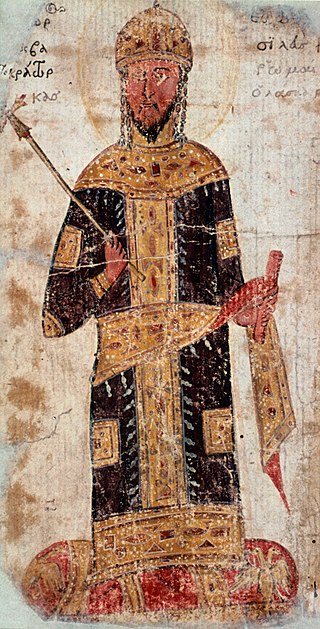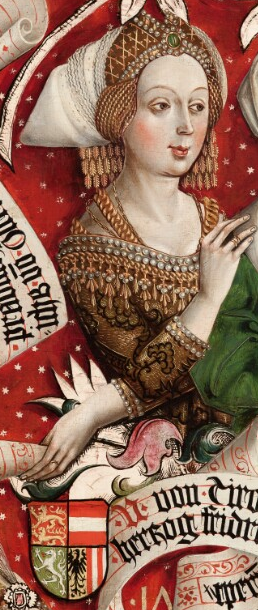Related Research Articles

Theodore I Laskaris or Lascaris was the first emperor of Nicaea—a successor state of the Byzantine Empire—from 1205 to his death. Although he was born to an obscure aristocratic family, his mother was related to the imperial Komnenos clan. He married Anna, a younger daughter of Emperor Alexios III Angelos in 1200. He received the title of despot before 1203, demonstrating his right to succeed his father-in-law on the throne.

Theodore II Doukas Laskaris or Ducas Lascaris was Emperor of Nicaea from 1254 to 1258. He was the only child of Emperor John III Doukas Vatatzes and Empress Irene Laskarina. His mother was the eldest daughter of Theodore I Laskaris who had established the Empire of Nicaea as a successor state to the Byzantine Empire in Asia Minor, after the crusaders captured the Byzantine capital, Constantinople, during the Fourth Crusade in 1204. Theodore received an excellent education from two renowned scholars, Nikephoros Blemmydes and George Akropolites. He made friends with young intellectuals, especially with a page of low birth, George Mouzalon. Theodore began to write treatises on theological, historical and philosophical themes in his youth.

John III Doukas Vatatzes, Latinized as Ducas Vatatzes, was Emperor of Nicaea from 1221 to 1254. He was succeeded by his son, known as Theodore II Laskaris.
George Akropolites was a Byzantine Greek historian and statesman born at Constantinople.
Robert I, also Robert of Courtenay, Latin Emperor of Constantinople, was a younger son of the emperor Peter II of Courtenay, and Yolanda of Flanders.
This is an alphabetical index of people, places, things, and concepts related to or originating from the Byzantine Empire. Feel free to add more, and create missing pages. You can track changes to the articles included in this list from here.
Anna Komnene Angelina or Comnena Angelina was an Empress of Nicaea. She was the daughter of the Byzantine Emperor Alexios III Angelos and of Euphrosyne Doukaina Kamatera.

Theodore Komnenos Doukas was the ruler of Epirus and Thessaly from 1215 to 1230 and of Thessalonica and most of Macedonia and western Thrace from 1224 to 1230. He was also the power behind the rule of his sons John and Demetrios over Thessalonica in 1237–1246.
The Laskaris or Lascaris family was a Byzantine Greek noble family whose members formed the ruling dynasty of the Empire of Nicaea from 1204 to 1261 and remained among the senior nobility up to the dissolution of the Byzantine Empire, whereupon many emigrated to Italy and then to Smyrna. According to George Pachymeres, they were also called Tzamantouros (Tζαμάντουρος). The feminine form of the name is Laskarina (Λασκαρίνα).

Maria Laskarina was a Greek Queen consort of Hungary by marriage to Béla IV of Hungary. She was the daughter of Theodore I Laskaris and Anna Komnena Angelina.

Anna of Hohenstaufen, born Constance, was an Empress of Nicaea. She was a daughter of Frederick II, Holy Roman Emperor and Bianca Lancia.
Elena Asenina of Bulgaria was an empress consort of Nicaea, married to Theodore II Laskaris. She was daughter of Bulgarian Emperor Ivan Asen II and Anna Maria of Hungary.
Marie de Courtenay was an Empress of Nicaea. She was a daughter of Peter II of Courtenay and Yolanda of Flanders. She married Theodore I of Nicaea. Marie served as regent for her younger brother Baldwin II of Courtenay in 1228, and styled herself "Empress of Constantinople".

Theodora Doukaina Komnene Palaiologina, usually known simply as Theodora Palaiologina, was the empress consort of the Byzantine emperor Michael VIII Palaiologos.
Eudoxia Laskarina Asanina, sometimes known as Laskara, was a member of the Byzantine Laskaris family. In later life, she fled to Aragon, where she was known as Irene Lascaris.

The Vatatzes or Batatzes family was a noble Byzantine Greek family of the 11th–14th centuries with several branches, which produced several senior generals of the Byzantine army and, after John III Doukas Vatatzes intermarried with the Laskaris family, the ruling line of the Empire of Nicaea until the usurpation of Michael VIII Palaiologos in 1261. The feminine form of the name is Vatatzina or Batatzina (Βατατζίνα).
Isaac Laskaris was a brother of Nicaean emperor Theodore I Laskaris, who along with his brother Alexios Laskaris fled to the Latin Empire and unsuccessfully tried to topple Theodore's successor, John III Doukas Vatatzes, in 1224.
Alexios Laskaris was a brother of Nicaean emperor Theodore I Laskaris, who along with his brother Isaac Laskaris fled to the Latin Empire and unsuccessfully tried to topple Theodore's successor, John III Doukas Vatatzes, in 1224.
Anseau de Cayeux or Anselm de Cayeux was a French knight from Picardy, who participated in the Fourth Crusade (1202-1204) and later became one of the leading nobles of the Latin Empire, serving as regent in Constantinople (1237-1238). He was married to Byzantine princess Eudokia Laskarina, younger daughter of former emperor Theodore I Laskaris.

Eudokia Laskarina Angelina was a Byzantine princess. She was a younger daughter of Emperor Theodore I Laskaris of Nicaea, and Anna Komnene Angelina.
References
- ↑ The Capetians-Courtenay
- ↑ There are many places in France called Neuville. The ancient County of Arras lies within the modern Pas-de-Calais department. There are five places called Neuville in Pas-de-Calais: Neuville-au-Cornet, Neuville-Bourjonval, Neuville-Saint-Vaast, Neuville-sous-Montreuil and Neuville-Vitasse. There seems no reason to prefer any one of them over the others as her birthplace.
- ↑ Angold 2011, p. 52-54.
- 1 2 George Acropolites, Chronicle, chapters 18-22
- ↑ George Acropolites, Chronicle, chapters 22
- ↑ Alberic of Trois-Fontaines, Chronica Alberici Monachi Trium Fontium, MGH SS XXIII
- ↑ Annales Mellicenses 1229, MGH SS IX,
- 1 2 William of Tyre Continuator, Chapters 18-19